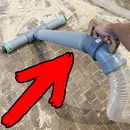Introduction: Sewer Pipe/scrap Wood Planters
Every woodworker has some scrap wood in his/her woodshop. There are countless ways to utilise this otherwise useless wood and now there is one more! I would like to share it with you guys!
Over the years quite a big amount of scrap wood had piled in the corners of my workshop. Eventually, it started to disturb me as the quantity of it was just too much. As my other hobby is (urban) gardening I also had two avocado trees that were ready to be planted in soil. I wanted planters that would look original, would not cost a lot and would suit my plants. Thus the concept for this project was born!
Follow me along as I show you how I made them and the failures I had. Be sure to check out the video!
Every maker is absolutely flattered when his/her work is appreciated! Show your appreciation by following me here on Instructables or on YouTube !
And of course, when you like this project please give it a vote in a contest and go check out some other entries there!
These planters were actually a gift to my good friend. He was really happy about it since he did not have any plants in his apartment. I have a bad feeling that all of them had died due to lack of care. Let's just hope that these avocados will not share the same faith!
Step 1: What You Will Need
For this build you will need:
- Scrap wood
- Sewer pipe
- End cap for sewer pipe
- Wood glue
- Some sort of finish (e.g. linseed oil)
Tools:
- Scroll saw or jig saw
- Lathe
- Some clamps
- Something to drill holes with
Having table saw and router also really eases the process.
The sewer pipe I used was a common (110 mm in diameter) one that can easily be found in any hardware store (at least here where I live). The end cap was also found there but it could also be made from some sort of material that does not rot.
Step 2: Preparinig the Scrap Wood
Wood for this build does not have to be perfect! Far from it - it can be cupped or otherwise deformed as long as you have clamps strong enough to press them flat. They can have different thicknesses and can be different materials. I used everything from thin ash veneer to 3 cm thick plywood. The end result was a pretty interesting pattern.
I started by cutting all my scrap wood into perfect squares on the table saw. After tracing the outline of the sewer pipe on the wood I cut the holes with the scroll saw.
I actually recommend making a template that has the hole perfectly aligned in the middle. This way you can use it to trace the hole locations on rest of the material.
If I were to do this project again I would use a router table with flush trim bit instead. This way a template could be used to make absolutely perfect circles. First removing most of the material with a hole saw and trimming it to the line with a router. It is usually really hard to follow a line with the scroll saw and thus the circles may not turn out so round.
Step 3: The Glue-up
This is a pretty straightforward process and does not need much explanation!
I did do it in two steps. First glueing the middle pieces and then the end pieces. I did this so I could better align the layers as wood glue makes thing pretty slippery. It also allowed me to easily trim the sewer pipe (with a hand saw) to final length as the top layer had a nice flat surface.
If the glue has fully dried it is also a good idea to remove the corners as it will make the turning process much easier. I did this by tilting my table saw to 45 degrees carefully making the four cuts.
Step 4: Turning
On my cheap lathe, I turned the planter to the desired shape. Go easy as you do not want to remove too much material and reveal the plastic pipe beneath like I did!
A bit of sanding (up to 220 grit) and decorative burn marks with a wire gave it a nice smooth look!
Step 5: Failures
Like always, nothing ever goes according to plan. So did this project!
I wanted to add thin layers of veneer to the stack. As I did not have any exotic colourful wood I decided to try staining the veneer myself. It was supposed to give a nice contrast to the yellowish softwood. I did not work out at all! The stain only penetrated a thin layer and it was not enough to be visible from the sides. Maybe if I had soaked it in stain it would have been more visible.
On the second planter, I removed a bit too much material while turning and a big piece flew off revealing the plastic pipe underneath. As I could not find the piece anymore I had to shorten the planter. Luckily it was not too big of a deal!
Step 6: The Final Touches
After turning it was time to make a hole on top of the planter. It could be done with a jig saw and files but I used a router with a flush trim bit. It worked really well.
As you can see the pipe is not perfectly in the middle. The second one was a bit better. To avoid this I really recommend making a perfect template with an ideal circle exactly in the middle and later referencing other pieces from it.
Finally, I did some sanding on the top and bottom and applied some finish. I used water based varnish on the first one and linseed oil on the second one. I must admit that the one that was oiled looks much better. What do you think?
Step 7: The End
Add soil and plants and that is it!
I hope you have enjoyed this project. If you did feel free to give it a vote in a contest.
And do not forget to follow me here on Instructables and subscribe on Youtube! I really appreciate it!
Take care!
Andu
And for anyone wondering the tip of the leaves are brown due to salts in tap water. Avocado is pretty sensitive about it.

First Prize in the
Indoor Gardening Contest 2016

Participated in the
Trash to Treasure Contest 2017

Participated in the
Homemade Gifts Contest 2016













